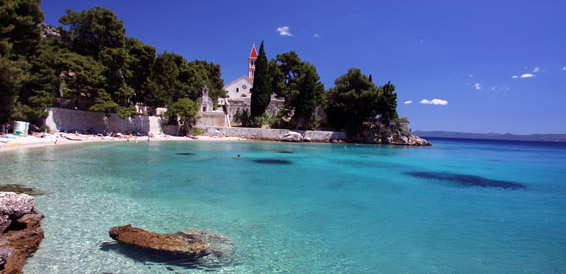
Central Dalmatia
Central Dalmatia is located around the city of Split, the second biggest Croatian city. It is a region where the Sun almost always shines, area with some of the most beautiful islands in Croatia, an ideal place for your vacations.
Central Dalmatia covers the area bordered by the Krka river and the Makarska riviera. The city of Split is settled on the foothills of the Marjan mountain, and has evolved around the impressive Diocletian's palace into a big city. The palace and the nearby town of Trogir's centre are on the UNESCO list of World Heritage Sites, which speaks immensely of their cultural importance. The history of the region dates back to the time BC, when the ancient Greeks inhabited the area.
The Makarska riviera is in the very south of the region. Renowned for its lovely beaches, shaded by pine and palm trees, it is overlooked by the Biokovo mounatin, which was declared a park of nature thanks to its beauty, animal and plant diversity, a huge part of which is situated in the Kostina botanical garden.
If you ever decide to set sail out towards the islands, even for a day, you will find the quiet beaches and the clear blue sea rejuvenating and peaceful.
The islands of Central Dalmatia are bigger and remoter from the mainland than the ones in North Dalmatia. Among the many stunning beaches on the biggest island of the area, Brac, Zlatni rat in Bol stands out as the most spectacular, with its unique 530 m long landform whose exact shape and length varies with regard to changes in tide, current, and wind. Apart from being known as the sunniest island in Croatia, Hvar is one of the most popular destinations in the Adriatic due to the romantic charm of its small towns and villages. A valuable part of the historic heritage is the Hvar theatre, one of the oldest baroque theatres in Europe. The island of Vis has just recently opened its doors to public tourism, yet it has already become one of the most popular destinations in the region. The fishing towns of Vis and Komiza and their ancient stone-paved streets evoke the times long gone by, with fishing nets hanging from the traditional taverns. With its crystal clear sea and unique blue light, the Blue Grotto on Bisevo is a sight beyond your wildest imaginations. In the past centuries, Vis, as an important strategic sailing point has seen many battles, both on and off the shore, some even in the air. Countless ship and airplane graveyards around the island stand witness to the turbulent times.
Exceptionally fresh fish and seafood and fine herbs and spices are the mainstay of lightly cooked or grilled dishes pertaining to the cuisine of Central Dalmatia. However, not everything is as simple as it seems. Many dishes bear a unique story of their own, such as pasta fazol na brudet, an incredible fusion that is beans and fish stew, or vitalac from Brac, a meal invented while waiting for lamb to be grilled. Every delicious meal is carefully accompanied with a glass or two of some exquisite and distinct Dalmatian wines.
The region of Central Dalmatia is, like most the of the Adriatic coast, under the influence of warm Mediterranean climate. The weather is best described as hot and dry. The area around Primosten and Ploce has no islands around to reduce the power of the wind blowing from the open sea, the so-called lebic, and is thus known for bigger waves than any other part in the rest of the Croatian Adriatic. Maestral, a mild northwestern, and in some places southwestern sea-to-coast wind is very common in the area. It makes the summer heat pleasant and easy to deal with.
Areas most affected by bura are Split, the Hvar channel, the eastern part of the Brac channel and Makarska with its surrounding area, especially during the winter. Jugo is a southeastern wind present througout the whole region, and usually is a sign of changing weather. Winds are mostly light to mild, and strong only occasionally, during winter.
Central Dalmatia is a region with the most sunny days a year and the least rain on average in the Croatian Adriatic. Due to this fact, the island of Hvar is known as „the sunny island“.